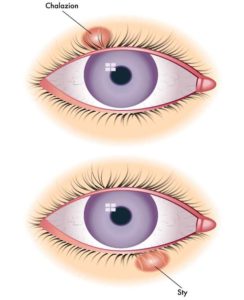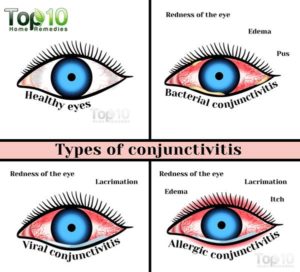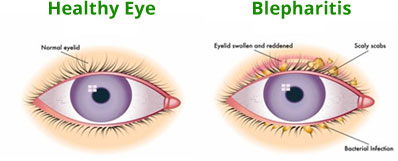Floaters
 Hordeolum (Eyelid Stye) and Chalazion
Hordeolum (Eyelid Stye) and Chalazion
A stye is a bacterial infection of an oil gland in the eyelid at the base of the eyelash. This results in a red bump on either the outside or inside of the eyelid. The internal styes are due to an infection of the meibomian gland and the external styes are from an infection of the Zeis gland.
A chalazion is a blocked oil gland WITHOUT infection. These are usually in the middle of the eyelid and not painful but sometimes will become so large that the eye will close. Both of these blockages can be triggered by poor nutrition, sleep deprivation, lack of hygiene and water, and rubbing eyes.
Using a warm compress and occasionally an antibiotic eye ointment, these glands will most likely be cleared up in a few days! A hordeolum will rupture and discharge material (pus) relieving pain within 2-4 days. A chalazion will rarely spontaneously rupture but when it does it sometimes erupts through the skin over a 2-8 week period.
______________________________________________________________________
Conjunctivitis (Pink Eye)
 Conjunctivitis, also known as pink eye, is an infection or inflammation of the conjunctiva – the thin, protective membrane that covers the surface of the eyeball and inner surface of the eyelids. Caused by bacteria, viruses, allergens and other irritants like smoke and dust, pink eye is highly contagious and is usually accompanied by redness in the white of the eye and increased tearing and/or discharge.
Conjunctivitis, also known as pink eye, is an infection or inflammation of the conjunctiva – the thin, protective membrane that covers the surface of the eyeball and inner surface of the eyelids. Caused by bacteria, viruses, allergens and other irritants like smoke and dust, pink eye is highly contagious and is usually accompanied by redness in the white of the eye and increased tearing and/or discharge.
There are three types of conjunctivitis:
- Viral conjunctivitis – This type of conjunctivitis is caused by a virus, like the common cold. This pink eye is very contagious, but usually will clear up on its own within several days without medical treatment.
- Bacterial conjunctivitis – This type of conjunctivitis is caused by bacteria. It can cause serious damage to the eye if left untreated.
- Allergic conjunctivitis – This type of conjunctivitis is caused by eye irritants such as pollen, dust and animal dander among susceptible individuals. Allergic conjunctivitis may be seasonal due to pollen or flare up year-round due to dust or pet dander.
_______________________________________________________________________________________________
Dry Eye Syndrome
Dry eye is a condition that can be chronic or temporary, where people cannot produce enough tears to nourish the eye. Luckily crying is not the only way to cover you eye with tears, every time you blink you produce a film of tears that spreads over the eye, keeping your eye surface smooth and clear of debris. When this protective coating dries up, the eyes may feel “gritty” or burn and can be more sensitive to light. In extreme cases, vision can be blurred. Often daily activities, like working on a computer can cause infrequent blinking which could lead to dry eye.
Symptoms of dry eye include:
- Burning sensation
- Itchy eyes
- Aching sensations
- Heavy eyes
- Fatigued eyes
- Sore eyes
- Dryness sensation
- Red eyes
- Photophobia (light sensitivity)
- Blurred vision
- Foreign body sensation — the feeling that grit or something is “in” your eye.
- Watery eyes: dryness on the eye may sometimes over-stimulate tears as a protective measure. This reflex through does not stay long enough to nourish the eye.
_______________________________________________________________________
Blepharitis
Blepharitis is a general term for an inflammation of the eyelid and eyelashes. It is among the most common and stubborn eye conditions usually resulting from poor eyelid hygiene, a low-grade bacterial infection (usually staphylococcal), an allergic reaction and/or abnormalities in oil gland function. Like some other skin conditions, blepharitis can be controlled but not cured. The main goals in treating it are to reduce the amount of bacteria along the lid margin and open plugged glands.

